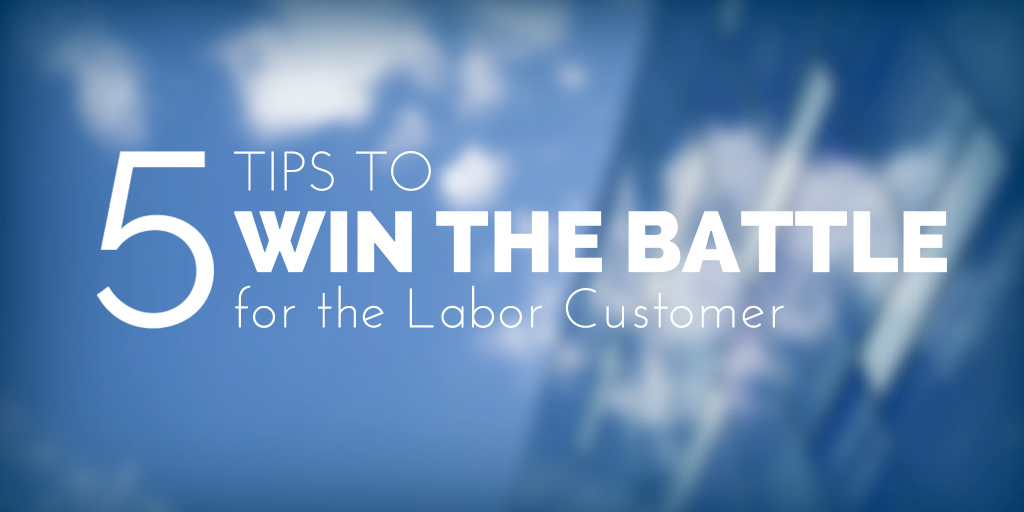
5 Tips to Win the Battle for the Labor Customer
This article was originally published on LinkedIn, here.
The war for talent is intensifying as the exit of baby-boomers hits the job markets. Having critical talent to manage operations and fuel growth becomes a key differentiator for successful organizations; finding the right talent and building an engaged workforce is as critical and challenging as finding, keeping and growing new customers and new business.
It’s a simple equation: business success requires satisfied customers, and the primary driver of satisfied customers is a committed workforce who listens and responds to customer needs while building great relationships. For that matter, the essence of any business is thus people business. Nevertheless, executive committees spend disproportional time monitoring business dashboards, reviewing operations and engineering business development and relatively less time on mastering the root cause of success or failure: the people thing.
Mastering people management starts with taking the right perspective. The concept of employment has evolved as companies alter their way of working (e.g. introducing project based work, flexible schedules, outsourcing, etc…) and new generations prevail personal priorities over professional aspirations. Employees, regardless of their employment contract, have become labor customers. By thinking of your workforce in terms of labor customers, people management all of a sudden becomes much more understandable and approachable.
Managing your labor customers works best by applying a marketing perspective to HR:
1. Build you brand
Labor customers have a choice. For them to consider you as a worthy employer you will need to portray an appealing brand. Your ‘total’ brand is the combination of your corporate, commercial and employer brand as everything you do speaks to your targets: the corporate reputation you have, the nature of products and services you offer, the employment value proposition you present and the feedback they get from people who already work for you. All these dimensions need to say the same thing and reinforce what your company is about. Make sure these messages resonate coherently to build a shared mindset and a preference with your target talent base.
2. Manage your funnel
Manage your funnel of candidates like you manage your commercial funnel. Design tactics to fill your candidate pipeline and tactics to convert your applicant throughout the hiring stages. The role of recruitment is not just selection; recruiters aren’t gatekeepers anymore who weed out the unsuitable to grant some selected few the privilege of working for you. The recruitment process is as much about selecting the right candidates as it is about providing unselected candidates with a great candidate experience and thus converting all your applicants into brand ambassadors who recommend you to other potential candidates or will be happy buying or promoting your product and service offering.
3. Drive preference
Accentuate the soft benefits. You know that price is only one of many decision drivers in a commercial context. For some people it is a critical one, but for many others, the ‘magic’ or ‘coolness’ of the company or its products blurs the premium price burden. People buy what they like, making the perception of value a subjective judgment. Same logic applies for contract negotiations: the odds of your preferred candidate choosing your company over alternative suitors will be largely driven by the feeling he or she has for your company rather than the salary he or she will earn. Make sure to advocate your culture, projects, career opportunities and remuneration benefits to reassure candidates that all their Maslowian needs will be met. Train your hiring managers to make sure they too understand that the essence of business is people business: people choose to work with certain people more than they choose to work for certain organizations. As Mick Jagger sang years ago:
It’s the singer, not the song.
4. Drive performance
It is all important to nurture engagement. Consider the following question: what do you do to cross or upsell your products and services? Probably a lot. Now, apply the same question to the labor customers that you have acquired: what do you do to engage them and drive their commitment to your business agenda? Hmmm. Spend time creating the right environment to nurture customer loyalty (retention) and maximize your revenue (performance) by giving your people what they want: a compelling mission & vision, inspirational leadership, accessible and motivating management, challenging projects, growth opportunities, control over their working conditions and autonomy in achieving their targets. Respect your workers; they demand to be treated seriously. Think of your relationship in terms of a value exchange and your fairness will pay dividends in commitment and output.
5. Focus on your NPS
Certainly in B2B and to some extend in B2C, your people are your most important brand ambassadors. A positive message that is carried by everyone that ever showed an interest in working with you or ever worked for you is probably the strongest marketing campaign your can ever build. In today’s overcrowded communication environment, people trust what other ‘users’ say much more than what you advertise. So make sure that your own workforce as well as all your historic applicants spread the word and drive your net promoter score.
Lovers sometimes jokingly say: Let’s get married for a while. That, in essence, is the concept of modern employment. It is a get-together with shared motives, explicit vows and mutual expectations in a fair value exchange. It has phases of flirting, romance, commitment and relationship and lasts as long as there is relevance. Happy hunting!
